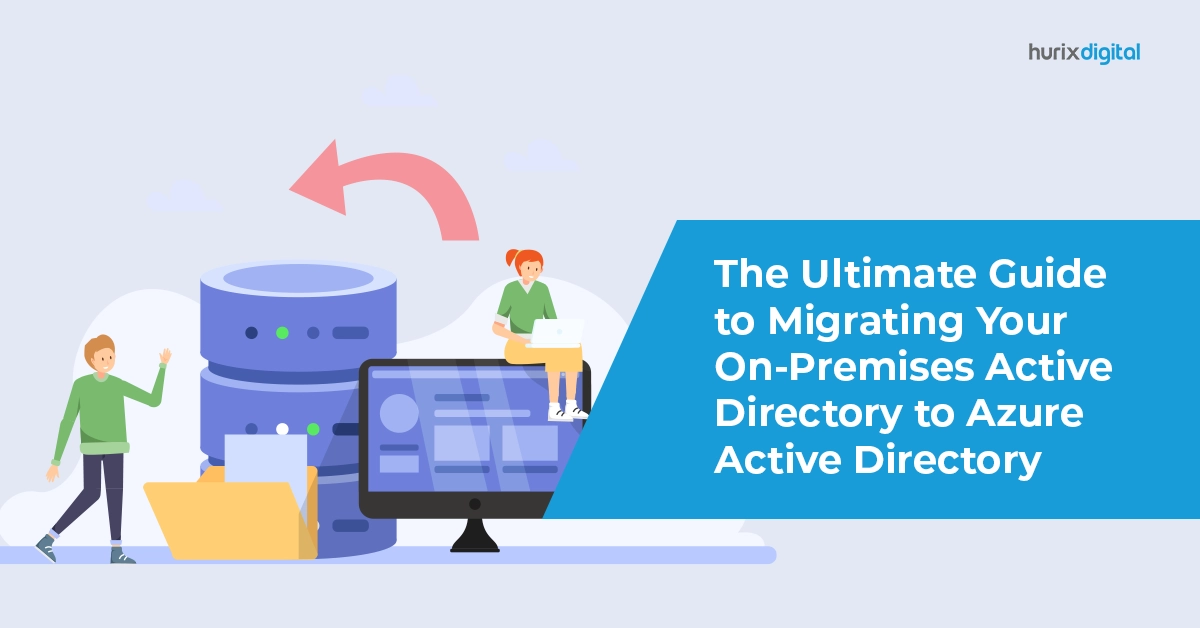
The Ultimate Guide to Migrating Your On-Premises Active Directory to Azure Active Directory
Summary
Learn what to consider when selecting a questionnaire editor. This blog offers tips for choosing an editor that meets your needs and enhances survey creation.
Azure Active Directory is a cloud service that provides Identity as a Service, authentication, authorization, and identity management functions for the company’s cloud and enterprise systems. It helps your employees sign in and access resources in external resources, such as Microsoft Office 365, the Azure portal, and thousands of other SaaS applications. Internal resources, such as apps on your corporate network and intranet, along with any cloud apps developed by your organization.
This blog is your guide to know more about Azure Active Directory!
Table of Contents:
- The Challenge for IT Admins
- Azure Active Directory Features
- Considerations to Keep in Mind Before Transitioning, from On-Premises Active Directory to Azure Active Directory
- Migrate On-Premises AD to Azure AD
- A View at the Industry Trends
- Conclusion
The Challenge for IT Admins
All employees in an organization need access to services to perform their duties. Employees can access services when the IT admin assigns them separate user IDs and passwords for every service. This is very difficult to manage multiple user IDs and passwords for employees and IT admin. In this type of situation, Azure Active Directory can help, IT admin needs to assign a single username and password to access all the services they want.
Azure Active Directory Features
- Single Sign-On (SSO): By utilizing a set of login credentials through Azure AD individuals can streamline their access to applications and services eliminating the hassle of managing multiple username and password combinations.
- Security Reports and Monitoring: reports with erratic sign-in behavior and possible weaknesses are provided.
- Integration with Microsoft Services: When combined with Microsoft cloud services such as Dynamics 365 Office 365 and SharePoint Azure AD offers an integrated user interface.
- Access Management: Azure Active Directory manages how applications and resources are accessed, making sure that authorized users have permission to access these resources.
- Multi-Factor Authentication (MFA): Azure Active Directory boosts security by mandating types of authentications like something you remember (password) something you possess (phone) or something, about you (data).
- Self-service Password Management: Users can change their passwords on their own without needing assistance from the IT department
- B2B and B2C Capabilities: Azure AD facilitates interactions between companies and customers, in both B2B and B2C settings.
- Identity Protection: Azure AD employs heuristics and adaptive machine learning algorithms to identify risks, like user activities or suspicious logins.
Also Read: The Power of Azure Express Route: Enhancing Cloud Connectivity for Businesses
Considerations to Keep in Mind Before Transitioning, from On-Premises Active Directory to Azure Active Directory
- Recognize Your Present Configuration: It is essential to have a complete grasp of your present on-premises AD architecture before you start the transfer process. To ensure you’re well informed it’s important to keep track of the number of users and groups, within your system the resources utilizing AD for authentication, and how your organizational units are set up.
- Select the Appropriate Tool: Microsoft provides AD Migration Tool and Azure AD Connect, as tools to assist in the migration process. It is critical to know how each tool works if you want to make the best decision based on the one that is most suitable for what you want
- Educate Your IT staff: Ensure that your IT team knows everything about Azure AD and comprehends the procedure for moving to it.
- This covers instructions on managing users and groups in Azure AD, using the Azure portal, and monitoring and debugging Azure AD.
- Post-Migration Support: After the migration, monitor your environment closely for any potential issues. Be prepared to provide support to your users as they adjust to the new system.
- Organize Your Migration: A smooth transfer can be ensured with the aid of a thorough migration plan.
- There should be a migration plan, the exact content to be moved, and backup plans in case things do not go as planned.
- Examine Before You Migrate: It would be prudent to try out the migration on a few of your data before moving all of it. This will help you spot possible difficulties and solve them before they can affect the whole business.
- Communicate with Your Users: Tell your users of the impending move and the changes they might anticipate. When the migration starts, this can lessen confusion and disturbance.
Migrate On-Premises AD to Azure AD
- Get Ready for the Migration
Recognize how your present on-premises AD is organized. Determine which resources are presently utilizing Active Directory for authentication. Arrange for the connection and authentication of these resources using Azure AD.
- Set Up Azure AD Connect
Azure AD Connect is a synchronization service intended to run between AD (Active Directory) and Azure AD. Having a single identity for users on Office 365, Azure, and other SaaS apps connected to Azure AD. Install Azure AD Connect on a server that can interface with your on-premises AD after downloading it. Select the right sync parameters during setup based on the requirements of your organization.
- Sync On-Premises AD with Azure AD
After setting up Azure AD Connect. Start the synchronization process. Keep an eye on the synchronization process to make sure it ends properly.
- Test the Migration
Test the migration before completing the move. Select a limited subset of resources or users to test. Ensure these users can access the required resources and authenticate using Azure AD.
- Make the Switch to Azure AD
Following a successful test.
Switch all users over to Azure AD authentication gradually from on-premises AD authentication.
Keep a watchful eye on this process so that any problems can be resolved.
- Decommission On-Premises AD
Once Azure AD is effectively being used by all users and resources. Discontinue using the Active Directory on-premises. Maintain your eye out for any possible problems with Azure AD.
A View at the Industry Trends
Many Organizations Adopting Azure AD nowadays. The reasons behind Azure AD’s selectivity compared to On-Premises are:
- Scalability: Given its awesome scalability, Azure AD does have the ability to accommodate a massive number of users as well as groups not requiring any more infrastructure.
- Accessibility: Azure Active Directory is a good choice for enterprises having remote workforce or multiple branches because you can access it anytime anywhere.
- Lower Expenses: By using Azure AD, companies can reduce the cost of maintaining their on-site computers and infrastructure.
- Security: Just a few of the strong security features that Azure AD provides include multi-factor authentication (MFA), identity protection, and conditional access controls.
- Connectivity to Microsoft Services: Integrating with other Microsoft services, such as Office 365, is easy and Azure AD provides a similar and regular user experience.
- Streamlined Administration: Administering groups in Azure AD and resetting your password yourself has been made easier with the help of these two features.
Also Read: 5 Steps to Setting Up a Secure Virtual Network with Azure Networking Services
Conclusion
Different advantages make transferring from an on-premises Active Directory to an Azure Active Directory very beneficial. They include scalability, accessibility, financial savings, and much more. However, successful migration requires detailed planning and follow-up action. If these rules are followed, organizations will be able to ensure the transition from their on-premises system to the cloud.
Hurix Digital’s Cloud Services helps your business get a smooth cloud adoption journey.
Contact Hurix Digital today!

Vice President and Strategic Business Unit Head – Cloud Services
A top technology management voice on LinkedIn with 20 Years of experience in Information Technology, Cloud Services, Digital Transformation, Application Modernisation, Managed Services, IT Security Engineering and Operations Management. An avid technology Leader, Leadership Speaker, Author & Coach.



